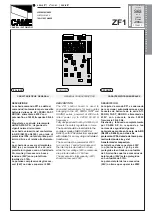
B METERS srl
Cod. Fisc. e P. IVA n°: IT01750340307
Tel. +39.0432.931415 - 931418
Via Friuli n°3
Cap. Soc. € 500.000,00 i.v.
Fax +39.0432.992661
33050 GONARS (UD)
Reg. Impr. di UD n° Iscr. 01750340307
ITALY
It’s necessary to:
1)
Select an appropriate relay:
With NO (normally open) or NC (normally closed) output depending on the type of input you want.
With an excitation coil voltage compatible with the available voltage. The voltage will normally be
the one supplied by the reading device (PLC for example) and must NOT be greater than 30V.
With a coil excitation current not exceeding 100mA.
These data are provided by the device manufacturer and are generally indicated by the relay technical
sheet. Then proceed as follows:
1)
Connect the relay input (excitation coil) to the IWM-PL3 or IWM-PL4 output as shown in the
diagram. One terminal of the coil must be connected to the supply voltage and the other must be
connected to the output of the IWM-PL3 or IWM-PL4.
2)
Connect the relay output (the “clean” contact) to the inputs of the external device (there is no
polarity).
In the example we referred to an electromechanical relay. There are semiconductor devices on the market,
called solid-state relays, which can be used.
The advantages are:
Less switching noise (no bounces, no noise emission, noiselessness)
Smaller footprint
Higher switching speed
The disadvantages are:
Greater cost
Minimum consumption but not zero even at rest
When switching speeds are high it’s preferable to use a suitably sized solid-state relay.




























